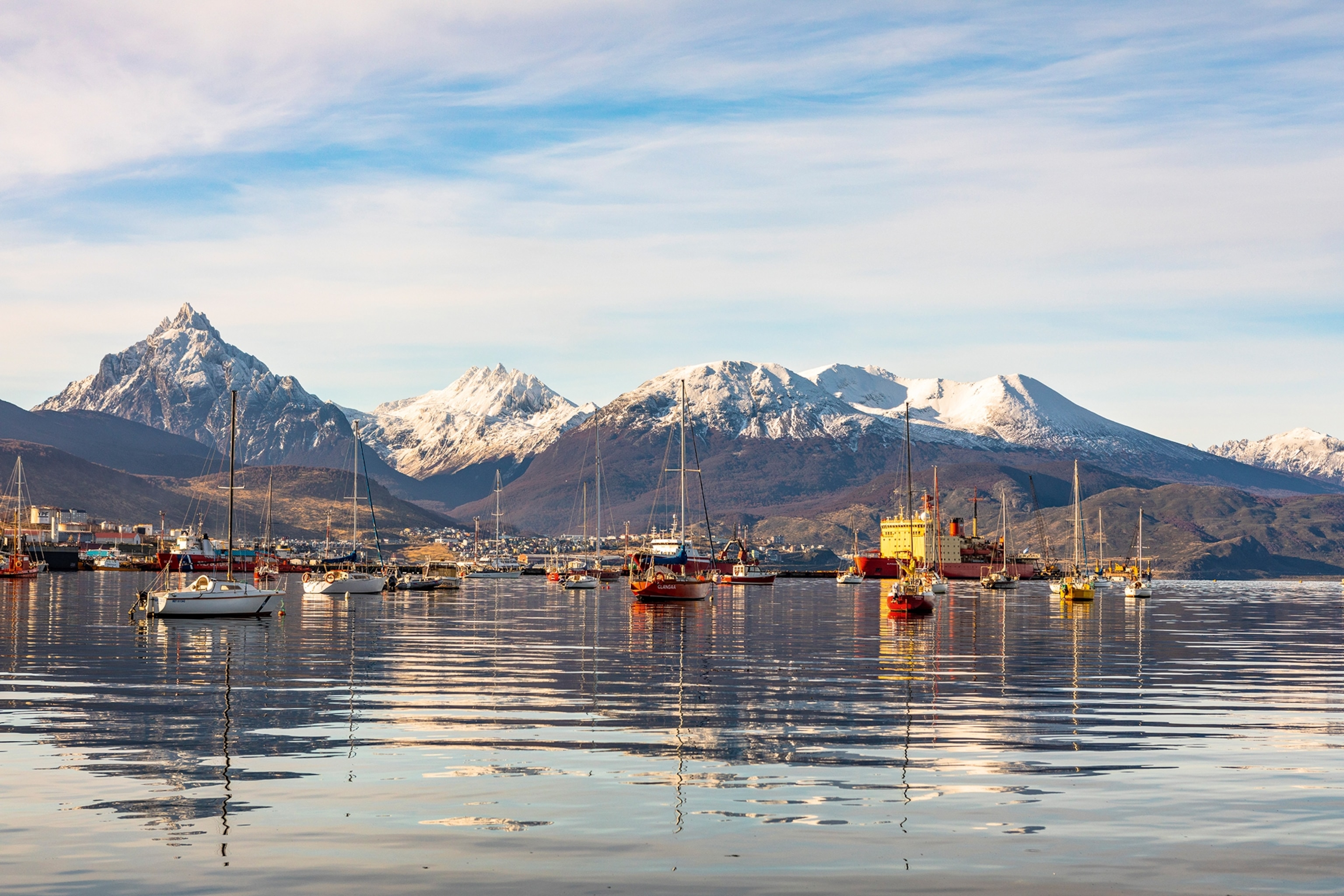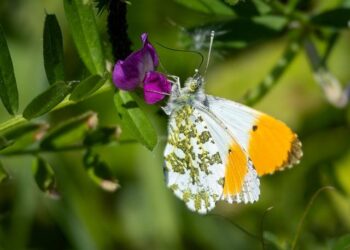This article was produced by National Geographic Traveller (UK).
Tracing the shoreline of the icy Ukika River, I follow a trail through an evergreen woodland of southern beech trees studded with clumps of orange fungi the shape and size of golfballs. The branches are miniature ecosystems, blanketed with tiny bryophytes (a group of plants that includes mosses, liverworts and hornworts) and tangled with a straggly lichen known as old man’s beard, which ripples as I pass. Sinuous roots and fallen trunks crisscross the path, while an ominous creaking rings out as the canopy shakes in the ferocious wind. There’s no one else around, but the pneumatic tapping of a Magellanic woodpecker periodically sounds above the din, its striking crimson head hidden from view.
Eventually, I emerge from Parque Municipal Ukika and watch as the river cuts across a stony beach and pours into the gunboat-grey Beagle Channel, which winds through Tierra del Fuego, linking the Atlantic and Pacific Oceans. On my right is the hamlet of Villa Ukika, home to the small Indigenous Yahgan community; to my left lie the outskirts of Puerto Williams, the southernmost city on Earth.
Below Patagonia, the tip of South America fragments into an archipelago of islands, islets, headlands and peninsulas riven by snaking waterways and draped with bottle-green forests and glistening glaciers. This is Tierra del Fuego (‘Land of Fire’). According to the oral traditions of the Indigenous Selk’nam people, the topography was created by a young man named Táyin who ‘grabbed stones, and with his sling[shot] hurled them in all directions. Where the stones landed there appeared large cracks in the ground which filled up with water’.

Tierra del Fuego’s poetic name was inspired by the bonfires of the Selk’nam.
Photograph by Christian Heeb, AWL Images
Tierra del Fuego’s poetic name was inspired by the bonfires of the Selk’nam, which were spotted by Portuguese explorer Ferdinand Magellan in 1520 as he attempted to complete the first circumnavigation of the globe. Half a millennium on, the sparsely populated region, which is shared by Argentina and Chile, remains a wilderness. That said, increasing numbers of tourists are heading to the Argentine port of Ushuaia, once a penal colony known as the ‘Siberia of the South’ and now the largest city in Tierra del Fuego, mainly to embark on Antarctic cruises.
But few of these travellers continue south across the Beagle Channel (named after the ship that carried a young Charles Darwin on his momentous voyage around South America) to Chile’s Navarino Island, home to Puerto Williams. The 2,800-person settlement, which had its status upgraded from a town to a city by the Chilean government in 2019, lies 1,500 miles from the capital, Santiago, yet a mere 670 miles from Antarctica.
Puerto Williams is only accessible by plane or boat, and its isolation is a big part of its draw. On my first visit, before the pandemic, I took the long route, catching a bus from the Chilean Patagonian port of Punta Arenas, crossing the stormy Strait of Magellan by ferry to Isla Grande in Tierra del Fuego, then continuing south into the Argentine section of the region and finishing 12 hours later in Ushuaia. The next day, I travelled by boat across the Beagle Channel, skirting raucous colonies of sea lions slumped across a chain of rocky islets, to reach the Chilean border post of Puerto Navarino, where I boarded a minibus for the final stretch along the coast to Puerto Williams.

The southern shore of the Beagle Channel backed by the Dientes de Navarino range.
Photograph by Kav Dadfar, AWL Images
This time, I opt for the quickest option: a 30-minute flight from Punta Arenas that provides spectacular views of the snow-bound Alberto de Agostini National Park. This area captured the imagination of Darwin, who wrote in The Voyage of the Beagle about pods of spouting whales, tempestuous weather and a landscape of ‘magnificent glaciers extend[ing] from the mountain side to the water’s edge. It is scarcely possible to imagine anything more beautiful than the beryl-like blue of these glaciers’.
On the southern shore of the Beagle Channel, backed by the thickly forested slopes and snowy serrated peaks of the Dientes de Navarino range, Puerto Williams is officially the capital of Chile’s Antarctic Province, but it retains the look and feel of a small town. Founded as a naval base in the 1950s, in an area long inhabited by Yahgan communities, it has a neighbourhood of spick-and-span whitewashed houses for military personnel and their families (who make up roughly half of the population), as well as a sprawl of mismatched civilian homes kitted out with large satellite dishes, stacks of firewood and, often, a shaggy dog.
In a burst of late-afternoon sunshine, I wander along the quiet, windswept streets, passing timber-walled churches, clusters of municipal buildings, a small school, some simple shops and restaurants (most of them closed) and a handful of guesthouses. Cows and horses roam freely, grazing on daisy-speckled lawns, and front doors are left unlocked, crime being a distant prospect in these parts. Pausing on a wooden boardwalk overlooking the Beagle Channel, I gaze out at a storm petrel whirling above a pair of fishing boats returning with a catch of supersized king crab.
After sampling the delicious crustaceans for dinner at a restaurant decked out with nautical knick-knacks, I chat with Anna Baldinger, who works at Hotel Fio Fio, the guesthouse I’m staying at. She originally moved to Puerto Williams from her native Austria to teach, before falling in love with both a local resident and Tierra del Fuego in general. “Puerto Williams is like being in a bubble — people think of it as the village at the end of the world,” she explains.
The city may only be 70 years old, but this region has been inhabited by Yahgan communities for millennia, as attested by the archaeological sites scattered across the surrounding countryside. Anthropologist Maurice Van de Maele, the owner of Hotel Fio Fio, tells me that Navarino is one of the top places in the world for archaeological density, estimating that there may be as many as 2,000 sites on the island. These include middens (prehistoric rubbish dumps) and circular depressions that once housed ancient shelters, scores of which I spot on the drive from Puerto Navarino.
Maurice is a former director of the local museum, formerly known as the Martin Gusinde Anthropological Museum. It was renamed the Museo Territorial Yagan Usi – Martín González Calderón to recognise the area’s long-overlooked Indigenous heritage. Situated on the western edge of Puerto Williams, the eye-catching institution has a hulking, sun-bleached whale skeleton on its grounds. Inside, it provides a fascinating insight into Yahgan culture through items such as finely carved bone harpoons, exquisite jewellery and expertly constructed wooden canoes.
The museum also highlights the devastation wrought on the indigenous peoples during the colonisation of Tierra del Fuego in the late 19th and early 20th centuries, a period that drew waves of missionaries, gold miners and sheep ranchers from Chile, Argentina and beyond.
This part of Tierra del Fuego can feel timeless, but change is coming. During my visit to Puerto Williams, I see only a dozen tourists, most of whom have come to hike, birdwatch, fish for wild trout or simply experience life at the ‘fin del mundo’ (‘end of the world’). But more are on their way: Antarctic cruise ships now call in more regularly, bringing hundreds of passengers in matching jackets, and a modern, multipurpose dock capable of serving larger vessels is being built. A large new hotel is also under construction and Puerto Williams’s tiny airport is being upgraded, including plans for a new passenger terminal.
The latter is one of a number of ongoing infrastructure projects in Tierra del Fuego. The tarmac on the country’s southernmost road, the Y-905, ends just east of Puerto Williams near Villa Ukika and is replaced by gravel for the final 13 miles to Caleta Eugenia, a lonely ranch owned by the Chilean navy. But there’s talk of extending the route to Puerto Toro, the world’s southernmost permanently inhabited settlement, currently only reachable by boat. A state-of-the-art scientific research hub, the Cape Horn Sub-Antarctic Centre, has also recently opened in the city. Perched on a hilltop east of the centre, this glass-and-concrete structure — complete with its own wind turbine — vaguely resembles a spaceship.
But as I hike west out of Puerto Williams, any nagging concerns about overdevelopment quickly melt away. There’s no one else on the trail up to the 2,000ft-high peak of Cerro Bandera (‘Flag Hill’), a switchbacking route that rises steeply through a beech forest and represents the first leg of the Dientes de Navarino circuit, an epic 33-mile trek. Gradually the trees thin out — the trunks increasingly stunted and bowed over, as if paying their respects — before disappearing completely at the top, replaced by a stark sub-polar tundra.

Parque Nacional Tierra del Fuego is a haven for hikers and birdwatchers.
Photograph by Maximilian Müller, Getty Images
Here, I find a Chilean flag straining at its pole like a puppy on a lead. The stony terrain is dotted with slow-growing cushion plants and snooker-table-green hummocks, and veined with ribbons of snow. With the white-flecked Beagle Channel to the north, the Dientes de Navarino piercing the sky to the south and no other hikers in sight, it is a gloriously secluded place featuring near-constant wind and a plunging temperature.
Remembering that this is just a false summit, I slip on another base layer and head on, following a route along a series of cairns for another 40 minutes until I reach an exposed ridge offering 360-degree views that somehow manage to surpass their forerunners, taking in a glacial lake ringed by a crown of snowy peaks. My hands are numb from the cold and the abrasive sleet provides an unwanted facial, but I can’t help smiling as I recall my conversation with Anna the previous day. “When you reach the top of Cerro Bandera, there’s no one else in front of you,” she had said. “And the rest of the world feels a long way away.”
How to do it:
Aerovías DAP operates flights between Punta Arenas and Puerto Williams, with flights taking a little over an hour.
Audley Travel offers a 16-day tour of Argentina and Chile, stopping in Ushuaia and Tierra del Fuego, from £12,100 per person including flights, in-destination transfers, accommodation, activities and excursions.
Published in the Latin America Collection 2024, distributed with the May 2024 issue of National Geographic Traveller (UK).
To subscribe to National Geographic Traveller (UK) magazine click here. (Available in select countries only).
>>> Read full article>>>
Copyright for syndicated content belongs to the linked Source : National Geographic – https://www.nationalgeographic.com/travel/article/hike-chile-tierra-del-fuego-end-of-the-world






























